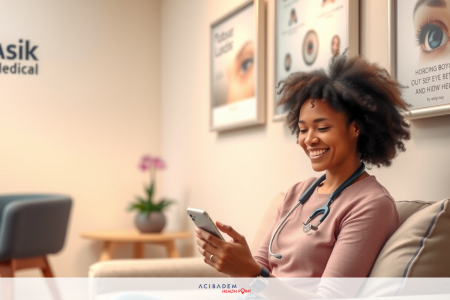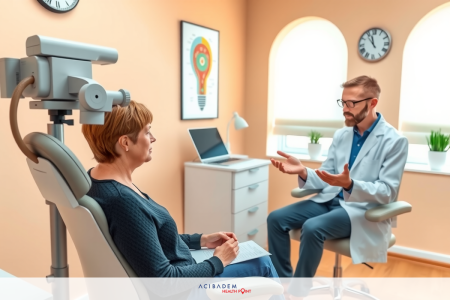Lagophthalmos Symptoms – Know the Signs
Lagophthalmos Symptoms – Know the Signs If you can’t close your eyes fully, you might have lagophthalmos. It’s key to spot the signs early to keep your eyes healthy. Taking the right steps is important.
Lagophthalmos can cause dryness and irritation. It also raises the chance of getting an infection. Knowing the signs helps you get help fast. It keeps your eyes healthy and lets you act quickly to prevent problems.
What is Lagophthalmos?
Lagophthalmos is when your eyelids don’t close all the way. This can be bad for your eyes. It means your eyes stay open and can get dry or hurt.
Definition and Overview
Lagophthalmos means you can’t shut your eyelids fully. It happens for many reasons. If your eyelid doesn’t close right, your eye stays open. This can make your eyes dry and might hurt them.
Some reasons for this include facial nerve paralysis. This is often seen in Bell’s palsy.
Types of Lagophthalmos
There are different kinds of lagophthalmos. Each has its own cause and effects:
- Paralytic Lagophthalmos: This is often from facial nerve paralysis. It happens when the muscles that move your eyelid get weak. Bell’s palsy is a common cause.
- Cicatricial Lagophthalmos: This is from scars or tight skin on the eyelid. It can come from injuries or surgery.
- Mechanical Lagophthalmos: This is when something physical stops your eyelid from closing. Like a tumor.
Knowing about these types and causes helps doctors treat it better. This can make your eyes healthier and help you feel better.
Here’s a table that shows the Types of Lagophthalmos:
| Type | Primary Cause | Common Conditions |
|---|---|---|
| Paralytic | Facial Nerve Paralysis | Bell’s Palsy |
| Cicatricial | Scarring or Contractures | Post-Surgical, Trauma |
| Mechanical | Obstructions or Anomalies | Tumors |
Common Causes of Lagophthalmos
It’s important to know why lagophthalmos happens. This helps with finding the right treatment. We’ll look at the main reasons for this condition.
Neurological Causes
Neurological issues can affect how our muscles and nerves work. This includes the nerves that control our eyelids. If the facial nerve gets damaged, it can make eyelids not close all the way. This is one way lagophthalmos starts.
Doctors need to check carefully to figure out what to do next.
Physical Trauma
Getting hurt can also cause lagophthalmos. This happens if the facial nerve gets damaged. This might be from a broken bone or cuts near the eye. Then, it’s hard to close the eyelids fully.
Fixing this often means surgery and careful treatment.
Medical Conditions
Some health issues can also lead to lagophthalmos. Conditions like Bell’s palsy or Guillain-Barré syndrome can hurt the facial nerve. These need a team of doctors to manage them right.
This team includes experts in neurology, immunology, and ophthalmology for the best care.
Recognizing Lagophthalmos Symptoms
It’s important to know the signs of lagophthalmos to get help early. This condition shows both visible and feeling symptoms. These signs help in getting help and stopping more problems.
Visible Signs
A big sign of lagophthalmos is an incomplete blink. This means the eyelids don’t close all the way when you blink. Look out if your eyelids don’t meet fully. Also, if your eyelids droop or pull back, it could be a sign too.
Sensory Symptoms
There are also feeling signs to watch for. People with lagophthalmos often feel chronic eye irritation. This can make your eyes feel dry, red, and gritty. Nocturnal symptoms are also important, like feeling dry or irritated at night. This can make it hard to sleep and keep your eyes healthy.
So, pay attention to both the things you can see and feel. Look for an incomplete blink, chronic eye irritation, and nocturnal symptoms. This helps in taking care of your eyes with lagophthalmos.
| Symptom Type | Indicators | Examples |
|---|---|---|
| Visible Signs | Incomplete Blink, Eyelid Abnormalities | Failure to fully close eyelids, Drooping eyelids |
| Sensory Symptoms | Chronic Eye Irritation, Nocturnal Symptoms | Eye redness, Gritty sensation, Nighttime dryness |
Dry Eye Syndrome
Dry eye syndrome often happens when the eyelids don’t close fully. This can make the eye dry and hurt. It’s important to know how lagophthalmos and dry eye are linked for treatment.
When the eyelids don’t close right, the eye doesn’t get enough moisture. This can make the eye feel dry, itchy, and blurry. The main problem is the tear film not working right. This film is key for keeping the eyes healthy.
Lagophthalmos can cause dry eye syndrome in several ways:
- Tear Film Dysfunction: Not closing eyelids enough messes up tear distribution, causing tear film dysfunction.
- Ocular Surface Compromise: A bad tear film makes the ocular surface weak, easy to get hurt or infected.
- Lubrication Deficiency: These issues lead to lubrication deficiency, keeping the eye dry and uncomfortable.
It’s important to act fast to help with dry eye from lagophthalmos. Here’s a table that shows dry eye symptoms and how they affect the eyes:
| Symptoms | Impact on Eye Health |
|---|---|
| Dryness | Leads to discomfort and potential corneal damage |
| Itching | Can cause further irritation and worsening symptoms |
| Visual Disturbances | May affect daily activities and overall quality of life |
Knowing and treating these symptoms can really help patients and their eye health. Make sure to see an eye doctor often to deal with dry eye from lagophthalmos.
Corneal Exposure and Damage
Corneal exposure is a big worry for people with lagophthalmos. It can cause many problems. It’s important to know about risks like keratitis, persistent epithelial defects, and vision loss. This helps protect eye health over time.
Corneal Drying
Corneal drying is an early sign of exposure. Without enough moisture, the cornea gets dry and weak. This can lead to lasting damage and make infections more likely.
Infection Risks
People with exposed corneas are more likely to get infections. Keratitis, a cornea inflammation, can happen easily. It’s important to see a doctor quickly to stop the infection from getting worse.
Vision Impairment
If corneal exposure is not treated, it can really hurt your vision. Defects and infections can make seeing things hard. So, it’s very important to take steps to protect your cornea to keep your vision good.
Nocturnal Lagophthalmos
Nocturnal lagophthalmos means your eyelids don’t fully close when you sleep. This can lead to eye problems during sleep. It’s important to know how it affects your eyes.
Sleep-Related Eyelid Issues: When your eyelids don’t close right, your cornea can get dry and irritated at night. The cornea needs your eyelids to protect it while you sleep.
Prevalence: Many people have nocturnal lagophthalmos but don’t know it. They might not find out until their eyes feel dry, red, or uncomfortable in the morning.
To manage symptoms, you can try a few things at night. Use eye ointments, wear special eye masks, and keep your room moist with a humidifier.
Seeing a doctor quickly can stop serious eye damage. If you have this issue, get advice from a doctor. Use protective steps to keep your eyes safe at night.
Diagnosis and Tests
Diagnosing lagophthalmos needs a detailed check-up. This ensures the right diagnosis and treatment. An eye doctor will do many tests and use special tools to see the condition clearly.
Clinical Examination
The first step is a clinical exam. The doctor checks how the eyelids move and the tears work. They look for signs of lagophthalmos and other issues.
They also ask about your symptoms and any past health problems. This helps them understand what’s going on.
Diagnostic Tools
After the exam, more tests are done. These tools help confirm the diagnosis and find out why you have lagophthalmos. Some important tests include:
- Slit-Lamp Examination – This shows a close-up of the eye to check for damage.
- Fluorescein Staining – It shows where the cornea is damaged by staining the tears.
- Imaging Techniques – Tools like ultrasound and OCT give detailed pictures of the eyes.
Using both clinical checks and technology helps get a full picture of lagophthalmos. This leads to better treatment plans for you.
| Diagnostic Tool | Purpose |
|---|---|
| Slit-Lamp Examination | Magnifies and illuminates the eye to detect corneal damage |
| Fluorescein Staining | Highlights damage to the cornea by staining the ocular surface |
| Ultrasound Biomicroscopy | Provides detailed images of the eyelid and anterior segment |
| Optical Coherence Tomography (OCT) | Offers high-resolution images of the ocular surface and structures |
Treatment Options
Lagophthalmos makes it hard for eyelids to close fully. There are many ways to help with this. The best treatment depends on how bad it is and what the patient needs.
Medical Therapies
Many people find relief without surgery. Using lubricating ointments helps keep eyes moist, especially at night. These ointments stop dryness and protect the cornea.
Doctors might also suggest special eye drops or goggles. These create a moist environment around the eyes. This helps with comfort and keeps the eyes safe.
Surgical Interventions
If medical treatments don’t work, surgery might be needed. Tarsorrhaphy is a surgery where the eyelids are sewn together a bit. This helps keep the eye moist and lowers the risk of infection.Lagophthalmos Symptoms
Eyelid reconstruction is for people with big problems or injuries. It fixes the eyelids to work right again. This might mean reshaping or grafting to look and work better.
| Treatment | Type | Benefits | Considerations |
|---|---|---|---|
| Lubricating Ointments | Medical Therapy | Easy to apply, reduces dryness | Requires regular application, temporary blurred vision |
| Tarsorrhaphy | Surgical Intervention | Reduces corneal exposure, prevents infection | Temporary discomfort, aesthetic considerations |
| Eyelid Reconstruction | Surgical Intervention | Restores eyelid function, improves appearance | Invasive procedure, longer recovery time |
Knowing about treatments like lubricating ointments, tarsorrhaphy, and eyelid reconstruction helps patients make good choices. This leads to better care and a better life.Lagophthalmos Symptoms
Preventive Measures
It’s important to take steps to lower the risk of lagophthalmos. Keeping your eyes clean and using protective eyewear are key. Regular eye check-ups also play a big role in keeping your eyes healthy.
Eye Protection
Wearing protective eyewear is a big help in preventing lagophthalmos. It’s useful when you’re at work, playing sports, or just outside. Brands like Oakley and 3M make goggles and glasses that are safe and look good.
Regular Check-ups
Going to the eye doctor often is important for your eyes. These visits can catch lagophthalmos early. Using things like clean eye wipes helps keep your eyes healthy too.
| Preventive Measure | Benefits | Recommended Products |
|---|---|---|
| Protective Eyewear | Shields eyes from hazards and irritants | Oakley Goggles, 3M Safety Glasses |
| Regular Check-ups | Early detection and treatment | Annual Ophthalmologist Visits |
| Ocular Hygiene | Prevents infections and maintains cleanliness | Sterile Eye Wipes, Saline Solutions |
Living with Lagophthalmos
Living with lagophthalmos can be tough, but you can make it easier. Learn the best ways to care for yourself every day. Knowing how to handle it and getting help from others can really help.Lagophthalmos Symptoms
Daily Care Tips
To deal with lagophthalmos, follow these steps every day. Use special eye drops during the day and thicker ointment at night to keep your eyes moist. Blinking a lot can also help keep your eyes wet.
Putting a humidifier in your home can also keep the air moist. This helps stop your eyes from getting too dry.Lagophthalmos Symptoms
Support Networks
Having a support network is key when you have lagophthalmos. Look for groups like the American Academy of Ophthalmology or the National Eye Institute for tips and advice. Online groups and local clubs can give you emotional support and useful tips.
Community resources are also there to help you. They make sure you can get the support you need to do well.
FAQ
What is lagophthalmos?
Lagophthalmos is when you can't close your eyelids fully. This can make your eyes dry and irritated.
What are the common causes of lagophthalmos?
It can happen from nerve problems, injuries, or some diseases. These issues can stop your eyelids from working right.
How can I recognize the symptoms of lagophthalmos?
Look for signs like not blinking fully or eyelid problems. You might also feel eye irritation or discomfort. Not closing your eyelids at night is another sign.
It can cause dry eye by not keeping the tear film right. Without proper eyelid closure, the eye surface gets dry, leading to dry eye symptoms.
What are the risks associated with corneal exposure due to lagophthalmos?
Corneal exposure can cause eye infections and damage. It can also hurt your vision and eye health. Protecting your cornea is key.
What is nocturnal lagophthalmos?
Nocturnal lagophthalmos means your eyelids don't close at night. This can make your eyes dry, irritated, and harm the eye surface. You need to protect your eyes at night.
How is lagophthalmos diagnosed?
Doctors check your eyes and use special tools to diagnose it. They look at how bad it is and what's causing it.
What are the treatment options for lagophthalmos?
Treatments range from eye drops to surgery. The right treatment depends on how bad your lagophthalmos is.
Are there preventive measures for lagophthalmos?
Yes, you can prevent it by keeping your eyes clean and using protective gear. Regular eye check-ups also help.
What daily care tips are recommended for living with lagophthalmos?
Use eye drops, keep your eyelids clean, and wear protective eyewear. Knowing about your condition and getting support helps too.
Is there a connection between facial nerve paralysis and lagophthalmos?
Yes, facial nerve paralysis, like from Bell's palsy, often causes lagophthalmos. It makes it hard to close your eyes fully.
Why is early detection of lagophthalmos important?
Finding it early stops eye problems like dryness and damage. Early action helps protect your eyes.













